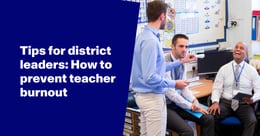
Teacher burnout also impacts students. Here’s how.
Teachers are primarily responsible for instructing students in the classroom and ensuring they hit grade-level learning targets. Still, those in the education sphere understand implicitly that the teaching role extends far beyond these key responsibilities.
From ensuring all students get the support they need, to directing after-school programs and grading assignments after hours, teachers are critical players in schools—and they often find themselves stretched in many different directions. Naturally, students are also absorbing some of this impact.
What lesson should administrators take away from this? Although the circumstances surrounding education are more demanding than ever, teachers are still giving it their all. The burnout many of them now face isn’t a personal shortcoming—it’s a consequence of the systemic problems impacting their field. Teachers deserve all the support we can give them to quell burnout, and their students do too.
What is teacher burnout?
Knowing how to prevent teacher burnout starts with understanding the issue at its core.
In short, job burnout is the result of chronic stress creating exhaustion across all fronts—including the individual’s mental and physical well-being. According to the Mayo Clinic, individuals grappling with burnout experience an overall sense of reduced accomplishment and personal identity.
Effects of teacher burnout
Teacher burnout symptoms might vary depending on the individual. However, some of the most common signs of teacher burnout revolve around a lasting sense of alienation, lack of interest in a role, and lowered job performance overall.
As with the symptoms of teacher burnout, the causes also vary. Researchers from Pennsylvania State University studying teacher stress and health identified four main contributors leading to the phenomenon:
- Culture: Weak relationships among colleagues, or among faculty and students, can heighten teachers’ stress and raise resignation rates. The same can be said for frequent principal turnover.
- Role-related demands: High-stakes obligations—think pressure surrounding standardized test scores or the challenge of quelling disruptive student behavior—can prove especially stressful and leave teachers emotionally vulnerable. Of course, heightened demands can also negatively impact work-life balance.
- Job autonomy: When teachers feel they’re unable to use their voice at work—and they can’t offer input on school decisions or they feel unable to set boundaries—their stress can increase. Likewise, robust co-worker support systems and control over how teachers carry out their jobs are key to avoiding burnout.
- Individual aspects: Without sufficient socioemotional skills, teachers are more likely to burn out when they face job-related stressors.
A snowball effect
Given factors such as the quick shift to online instruction and the challenge of unfinished learning, education professionals know that the COVID-19 pandemic has only added to the teacher burnout issue. Although historic figures placed teacher burnout rates between 5% and 30%, more recent data demonstrates a higher range of educators who feel overwhelmed.
According to 2021 reporting by Edutopia’s Kevin Leichtman on how to address burnout, there is also a “clear link between burnout and attrition,” and additional studies place the burnout rate at anywhere from 17% to 44%. Of course, this leads to additional stress on colleagues who are left behind.
With that in mind, what collective impact have these factors created? Put simply, they’ve created a teacher burnout epidemic.
How does teacher burnout affect students?
Although the burden of teacher burnout certainly falls most heavily on the educators it impacts, it has long been demonstrated to affect students’ learning as well.
This cyclical relationship between teacher well-being and its impact on student learning makes sense. When teachers don’t have the emotional support they need to perform at the top of their game, they’re unlikely to have the mental energy to offer that same support to students who need assistance.
In the journey toward creating healthier educators, highly fulfilling classrooms, and happy students, administrators and others within the wider school community should be aware of the following effects.
1. Widened achievement gaps
According to the Pennsylvania State University research referenced earlier, preexisting achievement gaps are at risk of widening further, given the ongoing teacher burnout epidemic.
Why? In short, considering that we know teacher attrition is linked to burnout—and that it’s more likely to occur within socioeconomically disadvantaged schools—students in the hardest-hit classrooms lose out on the benefits of ongoing, meaningful relationships with their educators.
After all, according to the National Education Association, researchers from the University of Florida and Vanderbilt University estimate that classrooms with teachers who leave during the school year might lose 32 to 72 days of instructional time, leading to significant interruption of learning and disruption among students. In short, the effects of this teacher shortage create ripples that impact both individual student learning and communities as a whole.
At the same time, teachers experiencing burnout who remain in the classroom could potentially foster environments lower in student engagement—in turn, this could have an adverse effect on students’ academic performance. The EdCan Network notes that among other things, teachers’ feelings of burnout and depersonalization might link back to lower measures of student motivation and success. Although this impact on student performance might not exacerbate achievement gaps directly, it could add another layer to this already complex issue.
2. Classroom management issues
When teachers must grapple with burnout and their day-to-day job responsibilities, instructional quality could falter. Experts note that teachers dealing with burnout and stress may fall back on less effective instructional strategies.
Here, the impact is twofold: On the one hand, burnout negatively impacts instructional clarity and hinders teachers’ ability to manage classroom mishaps and disruptions. And on the other, the classroom environments these teachers foster during such stressful periods will be less engaging and enriching for their students.
In fact, research published in the Journal of Educational Psychology suggests that teachers’ feelings of depersonalization are linked to lowered student cooperation and increased classroom disruption.
3. Stress contagion
Teachers’ stress and burnout is not limited to impacting achievement gaps or classroom management issues. In reality, it has a quantifiable impact on students’ brain chemistry as well.
Incredibly, in a sample of more than 400 elementary school students, researchers found that cortisol levels—colloquially known as the “stress hormone”—were highest in students with teachers who were experiencing significant burnout or emotional exhaustion. In other words, teachers’ stress was seemingly contagious for students.
Although research in this area is fairly limited and additional insight is needed, the findings paint a striking picture of the very physical and emotional effects teacher burnout could have on students.
A final note on the effects of teacher burnout on students
Given these considerations, it’s clear that teacher burnout is a multifaceted issue. Solving the teacher burnout problem will do even more than ensure healthier, more fulfilled educators staff our schools and classrooms—although this is certainly a critical goal.
Developing solutions for burnout also addresses the vexing school staffing shortages that have grown throughout COVID-19, and new strategies can make a positive impact on students’ wellness and achievement. This problem is holistic at its core. In turn, it’s vital to address teacher burnout as thoroughly as we can.
Helping educators avoid teacher burnout lets them focus on what they do best: helping students thrive. Download our ebook for expert insights on how 24/7 tutoring programs can free up teachers’ precious time and bolster students’ success both inside and outside the classroom.






